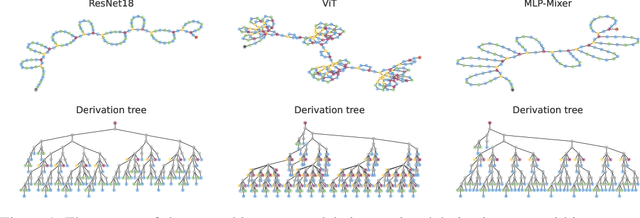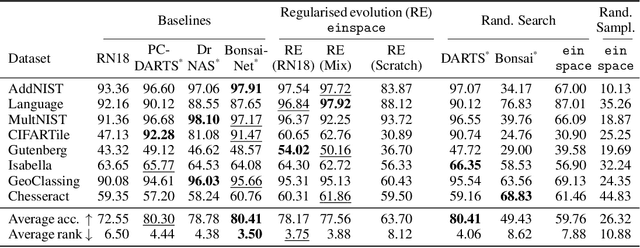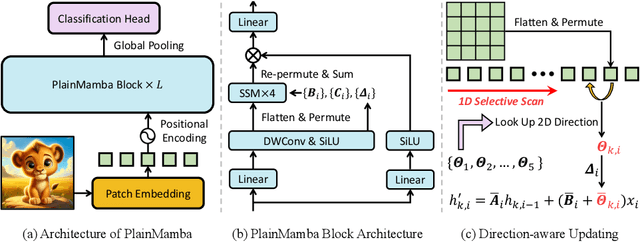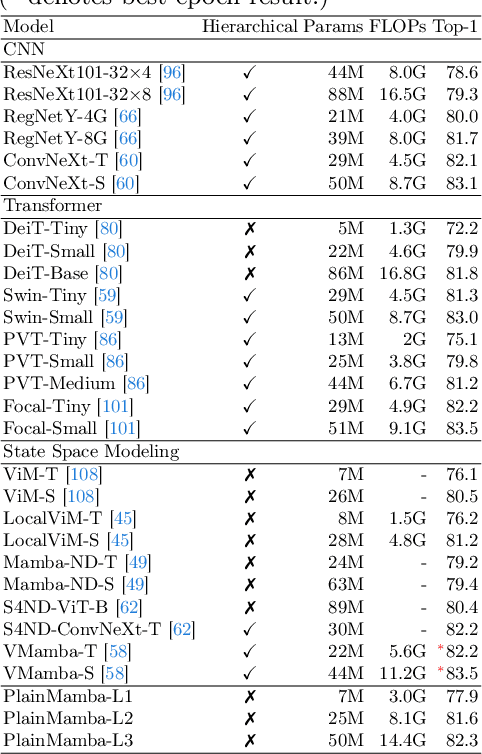Elliot J. Crowley
ONNX-Net: Towards Universal Representations and Instant Performance Prediction for Neural Architectures
Oct 06, 2025Abstract:Neural architecture search (NAS) automates the design process of high-performing architectures, but remains bottlenecked by expensive performance evaluation. Most existing studies that achieve faster evaluation are mostly tied to cell-based search spaces and graph encodings tailored to those individual search spaces, limiting their flexibility and scalability when applied to more expressive search spaces. In this work, we aim to close the gap of individual search space restrictions and search space dependent network representations. We present ONNX-Bench, a benchmark consisting of a collection of neural networks in a unified format based on ONNX files. ONNX-Bench includes all open-source NAS-bench-based neural networks, resulting in a total size of more than 600k {architecture, accuracy} pairs. This benchmark allows creating a shared neural network representation, ONNX-Net, able to represent any neural architecture using natural language descriptions acting as an input to a performance predictor. This text-based encoding can accommodate arbitrary layer types, operation parameters, and heterogeneous topologies, enabling a single surrogate to generalise across all neural architectures rather than being confined to cell-based search spaces. Experiments show strong zero-shot performance across disparate search spaces using only a small amount of pretraining samples, enabling the unprecedented ability to evaluate any neural network architecture instantly.
No time to train! Training-Free Reference-Based Instance Segmentation
Jul 03, 2025Abstract:The performance of image segmentation models has historically been constrained by the high cost of collecting large-scale annotated data. The Segment Anything Model (SAM) alleviates this original problem through a promptable, semantics-agnostic, segmentation paradigm and yet still requires manual visual-prompts or complex domain-dependent prompt-generation rules to process a new image. Towards reducing this new burden, our work investigates the task of object segmentation when provided with, alternatively, only a small set of reference images. Our key insight is to leverage strong semantic priors, as learned by foundation models, to identify corresponding regions between a reference and a target image. We find that correspondences enable automatic generation of instance-level segmentation masks for downstream tasks and instantiate our ideas via a multi-stage, training-free method incorporating (1) memory bank construction; (2) representation aggregation and (3) semantic-aware feature matching. Our experiments show significant improvements on segmentation metrics, leading to state-of-the-art performance on COCO FSOD (36.8% nAP), PASCAL VOC Few-Shot (71.2% nAP50) and outperforming existing training-free approaches on the Cross-Domain FSOD benchmark (22.4% nAP).
Transferrable Surrogates in Expressive Neural Architecture Search Spaces
Apr 18, 2025Abstract:Neural architecture search (NAS) faces a challenge in balancing the exploration of expressive, broad search spaces that enable architectural innovation with the need for efficient evaluation of architectures to effectively search such spaces. We investigate surrogate model training for improving search in highly expressive NAS search spaces based on context-free grammars. We show that i) surrogate models trained either using zero-cost-proxy metrics and neural graph features (GRAF) or by fine-tuning an off-the-shelf LM have high predictive power for the performance of architectures both within and across datasets, ii) these surrogates can be used to filter out bad architectures when searching on novel datasets, thereby significantly speeding up search and achieving better final performances, and iii) the surrogates can be further used directly as the search objective for huge speed-ups.
COP-GEN-Beta: Unified Generative Modelling of COPernicus Imagery Thumbnails
Apr 14, 2025Abstract:In remote sensing, multi-modal data from various sensors capturing the same scene offers rich opportunities, but learning a unified representation across these modalities remains a significant challenge. Traditional methods have often been limited to single or dual-modality approaches. In this paper, we introduce COP-GEN-Beta, a generative diffusion model trained on optical, radar, and elevation data from the Major TOM dataset. What sets COP-GEN-Beta apart is its ability to map any subset of modalities to any other, enabling zero-shot modality translation after training. This is achieved through a sequence-based diffusion transformer, where each modality is controlled by its own timestep embedding. We extensively evaluate COP-GEN-Beta on thumbnail images from the Major TOM dataset, demonstrating its effectiveness in generating high-quality samples. Qualitative and quantitative evaluations validate the model's performance, highlighting its potential as a powerful pre-trained model for future remote sensing tasks.
There is no SAMantics! Exploring SAM as a Backbone for Visual Understanding Tasks
Nov 22, 2024Abstract:The Segment Anything Model (SAM) was originally designed for label-agnostic mask generation. Does this model also possess inherent semantic understanding, of value to broader visual tasks? In this work we follow a multi-staged approach towards exploring this question. We firstly quantify SAM's semantic capabilities by comparing base image encoder efficacy under classification tasks, in comparison with established models (CLIP and DINOv2). Our findings reveal a significant lack of semantic discriminability in SAM feature representations, limiting potential for tasks that require class differentiation. This initial result motivates our exploratory study that attempts to enable semantic information via in-context learning with lightweight fine-tuning where we observe that generalisability to unseen classes remains limited. Our observations culminate in the proposal of a training-free approach that leverages DINOv2 features, towards better endowing SAM with semantic understanding and achieving instance-level class differentiation through feature-based similarity. Our study suggests that incorporation of external semantic sources provides a promising direction for the enhancement of SAM's utility with respect to complex visual tasks that require semantic understanding.
einspace: Searching for Neural Architectures from Fundamental Operations
May 31, 2024



Abstract:Neural architecture search (NAS) finds high performing networks for a given task. Yet the results of NAS are fairly prosaic; they did not e.g. create a shift from convolutional structures to transformers. This is not least because the search spaces in NAS often aren't diverse enough to include such transformations a priori. Instead, for NAS to provide greater potential for fundamental design shifts, we need a novel expressive search space design which is built from more fundamental operations. To this end, we introduce einspace, a search space based on a parameterised probabilistic context-free grammar. Our space is versatile, supporting architectures of various sizes and complexities, while also containing diverse network operations which allow it to model convolutions, attention components and more. It contains many existing competitive architectures, and provides flexibility for discovering new ones. Using this search space, we perform experiments to find novel architectures as well as improvements on existing ones on the diverse Unseen NAS datasets. We show that competitive architectures can be obtained by searching from scratch, and we consistently find large improvements when initialising the search with strong baselines. We believe that this work is an important advancement towards a transformative NAS paradigm where search space expressivity and strategic search initialisation play key roles.
Hyperparameter Selection in Continual Learning
Apr 09, 2024



Abstract:In continual learning (CL) -- where a learner trains on a stream of data -- standard hyperparameter optimisation (HPO) cannot be applied, as a learner does not have access to all of the data at the same time. This has prompted the development of CL-specific HPO frameworks. The most popular way to tune hyperparameters in CL is to repeatedly train over the whole data stream with different hyperparameter settings. However, this end-of-training HPO is unrealistic as in practice a learner can only see the stream once. Hence, there is an open question: what HPO framework should a practitioner use for a CL problem in reality? This paper answers this question by evaluating several realistic HPO frameworks. We find that all the HPO frameworks considered, including end-of-training HPO, perform similarly. We therefore advocate using the realistic and most computationally efficient method: fitting the hyperparameters on the first task and then fixing them throughout training.
PlainMamba: Improving Non-Hierarchical Mamba in Visual Recognition
Mar 26, 2024



Abstract:We present PlainMamba: a simple non-hierarchical state space model (SSM) designed for general visual recognition. The recent Mamba model has shown how SSMs can be highly competitive with other architectures on sequential data and initial attempts have been made to apply it to images. In this paper, we further adapt the selective scanning process of Mamba to the visual domain, enhancing its ability to learn features from two-dimensional images by (i) a continuous 2D scanning process that improves spatial continuity by ensuring adjacency of tokens in the scanning sequence, and (ii) direction-aware updating which enables the model to discern the spatial relations of tokens by encoding directional information. Our architecture is designed to be easy to use and easy to scale, formed by stacking identical PlainMamba blocks, resulting in a model with constant width throughout all layers. The architecture is further simplified by removing the need for special tokens. We evaluate PlainMamba on a variety of visual recognition tasks including image classification, semantic segmentation, object detection, and instance segmentation. Our method achieves performance gains over previous non-hierarchical models and is competitive with hierarchical alternatives. For tasks requiring high-resolution inputs, in particular, PlainMamba requires much less computing while maintaining high performance. Code and models are available at https://github.com/ChenhongyiYang/PlainMamba
EgoPoseFormer: A Simple Baseline for Egocentric 3D Human Pose Estimation
Mar 26, 2024



Abstract:We present EgoPoseFormer, a simple yet effective transformer-based model for stereo egocentric human pose estimation. The main challenge in egocentric pose estimation is overcoming joint invisibility, which is caused by self-occlusion or a limited field of view (FOV) of head-mounted cameras. Our approach overcomes this challenge by incorporating a two-stage pose estimation paradigm: in the first stage, our model leverages the global information to estimate each joint's coarse location, then in the second stage, it employs a DETR style transformer to refine the coarse locations by exploiting fine-grained stereo visual features. In addition, we present a deformable stereo operation to enable our transformer to effectively process multi-view features, which enables it to accurately localize each joint in the 3D world. We evaluate our method on the stereo UnrealEgo dataset and show it significantly outperforms previous approaches while being computationally efficient: it improves MPJPE by 27.4mm (45% improvement) with only 7.9% model parameters and 13.1% FLOPs compared to the state-of-the-art. Surprisingly, with proper training techniques, we find that even our first-stage pose proposal network can achieve superior performance compared to previous arts. We also show that our method can be seamlessly extended to monocular settings, which achieves state-of-the-art performance on the SceneEgo dataset, improving MPJPE by 25.5mm (21% improvement) compared to the best existing method with only 60.7% model parameters and 36.4% FLOPs.
WidthFormer: Toward Efficient Transformer-based BEV View Transformation
Jan 15, 2024



Abstract:In this work, we present WidthFormer, a novel transformer-based Bird's-Eye-View (BEV) 3D detection method tailored for real-time autonomous-driving applications. WidthFormer is computationally efficient, robust and does not require any special engineering effort to deploy. In this work, we propose a novel 3D positional encoding mechanism capable of accurately encapsulating 3D geometric information, which enables our model to generate high-quality BEV representations with only a single transformer decoder layer. This mechanism is also beneficial for existing sparse 3D object detectors. Inspired by the recently-proposed works, we further improve our model's efficiency by vertically compressing the image features when serving as attention keys and values. We also introduce two modules to compensate for potential information loss due to feature compression. Experimental evaluation on the widely-used nuScenes 3D object detection benchmark demonstrates that our method outperforms previous approaches across different 3D detection architectures. More importantly, our model is highly efficient. For example, when using $256\times 704$ input images, it achieves 1.5 ms and 2.8 ms latency on NVIDIA 3090 GPU and Horizon Journey-5 computation solutions, respectively. Furthermore, WidthFormer also exhibits strong robustness to different degrees of camera perturbations. Our study offers valuable insights into the deployment of BEV transformation methods in real-world, complex road environments. Code is available at https://github.com/ChenhongyiYang/WidthFormer .
 Add to Chrome
Add to Chrome Add to Firefox
Add to Firefox Add to Edge
Add to Edge